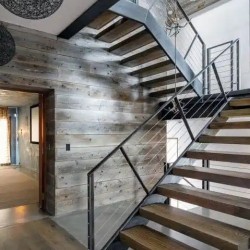Stairs in buildings and structures perform an important function - they provide safe and convenient access to various levels of a building or structure. Here are some specific examples:
Stairs in multi-story buildings: Stairs in multi-story buildings are used for emergency evacuation of people in the event of a fire or other emergency when it is necessary to quickly and safely leave the building. They are also used as a back-up way to higher floors when the lift is out of service.
Ladders in manufacturing facilities: In industrial buildings and structures, stairs are used for maintenance and repair of equipment, as well as for access to different levels of the building.
Stairs in streets and parks: Stairs can be used in parks and streets to provide safe and convenient access to hills, embankments, observation decks and other places of interest.
Stairs in residential buildings: Stairs in residential buildings provide access to different levels of the building and are an important element of the interior. They can also be used as a decorative element to create a unique and aesthetically pleasing design.
These are just some of the examples of the use of stairs in buildings and structures. They can be used in various industries and for various purposes, and the choice of a particular type of stairs depends on the specific purpose and requirements of the project.
There are many types of stairs, and their choice depends on the specific purpose, the space in which they will be used, and aesthetic preferences. Here are some of the most common types of stairs:
Straight staircase: This is the simplest and most common type of stairs, which consists of a straight vertical axis and horizontal steps. Straight stairs are commonly used in homes as well as industrial and commercial buildings.
Spiral Staircase: Spiral staircases consist of a central pivot around which spiral steps wrap. They take up less space than straight ladders and can be used where space is limited. Spiral staircases are often used in country houses, terraces, towers and basements.
Stringer stairs: Stringer stairs have vertical stringers (supports) to which steps are attached. They can be either straight or curved and are often used in multi-story buildings.
Landing Stairs: This type of staircase has an intermediate landing between floors. They can be straight or screw type and are often used in homes and offices.
Hand Ladder: Hand ladders are used to access high places such as shelves, cabinets, etc. They can be folded or folded out and can be made from wood, metal, or other materials.
These are just some of the most common types of stairs, and the choice of a particular type depends on the needs and requirements of a particular project.
Stairs can be made from a variety of materials including:
Metal: Metal stairs are one of the most common and durable types of stairs. Metal stairs can be made of steel, aluminum, stainless steel and other metal alloys. They are often used in industry and outdoor areas.
Wood: Stairs made of wood create a warm and cozy atmosphere in the interior, which makes them popular for use in residential areas. Wooden stairs can be made from a variety of woods including oak, ash, beech, pine, and more.
Glass: Glass stairs can create an effect of transparency and lightness, making them ideal for use in modern interiors. Glass stairs can be made of tempered glass or laminated glass.
Stone: Stone stairs can create a majestic and elegant look in an interior. Stone stairs can be made of marble, granite, limestone and other types of stone.
Mixed Materials: Stairs can also be made from a combination of materials such as metal and wood, metal and glass, etc.
The choice of material depends on the requirements of the project, interior style, functionality and design, as well as on the individual preferences of the customer.
Ice lighting can be used in stairs to create the effect of step lighting. This can not only give the stairs an aesthetic appeal, but also ensure the safety of the users of the stairs. With the help of LED lighting, you can create different effects, for example, even illumination of each step or illumination of only the edges of the steps. LED lighting can be installed inside the steps, under them or in the side slots of the stairs, depending on the requirements of the project and design.






















